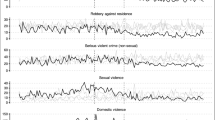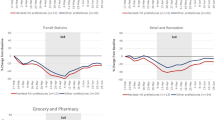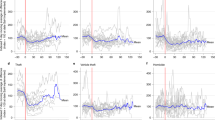Abstract
Criminal behavior, which takes its content from society, has been associated with social isolation, national quarantine, and mandatory stay-at-home measures during the COVID-19 pandemic, and it has been researched through crime rates. Moreover, it has been argued that changes in the level of social mobility also affect crime rates. Decreased crime rates have been reported during closure measures, and a significant literature has emerged based on these propositions. This study's retrospective approach was created to examine the appearance of crime rates in Türkiye. The main problem of the research is to reveal the relationship between crime, pandemic, and social mobility in Türkiye. For this purpose, it aimed to test the propositions based on a dual approach. First, patterns in crime rates were discovered. The data set regarding the most common crime types between 2018 and 2022, including pre-pandemic crime rates, was used. The most appropriate time series model was determined to understand the data structure regarding crime types, and it was tested whether there was a decrease or increase in crime rates during and after the pandemic. As a second step, the effect of social mobility on the change in crime was examined according to the mobility level data reported in this process. Evidence has shown decreased violence, theft, and drug crimes in the early part of the pandemic, consistent with the literature. While theft crimes decreased throughout the pandemic, violence and drug crimes increased. The view that crime rates will decrease if social mobility is restricted as a source of social life presented overlapping data in the pandemic. Changes in social mobility during the pandemic have affected crime rates for theft, injury, and drug use. Although there was a decrease in crime rates due to seasonal effects after the normalization process, it was observed that crime rates could change according to the content of social measures during the pandemic period. It is considered that this situation presents a particular slice for the future.






Similar content being viewed by others
Data availability
Available upon request.
References
aa. (2021). Türkiye'nin 1 yıllık Kovid-19'la mücadele sürecinin 'tedbir karnesi, Retrieved June 12, 2022, from https://www.aa.com.tr/tr/koronavirus/turkiyenin-1-yillik-kovid-19la-mucadele-surecinin-tedbir-karnesi/2171001. Accessed 15 Jun 2022.
Abrams, D. S. (2021). COVID and crime: An early empirical look. Journal of Public Economics, 194, 104344. https://doi.org/10.1016/j.jpubeco.2020.104344
Abt, T., Rosenfeld, R., & Lopez, E. (2020). COVID-19 and homicide: Final report to Arnold Ventures. Houston, TX: Arnold Ventures.
Agnew, R. (1999). A general strain theory of community differences in crime rates. Journal of Research in Crime and Delinquency, 36(2), 123–155.
Altunkaynak, A., & Başakın, E. (2018). Zaman Serileri Kullanılarak Nehir Akım Tahmini ve Farklı Yöntemlerle Karşılaştırılması. Erzincan University Journal of Science and Technology, 11(1), 92–101.
Ariel, B. and Bland, M. (2019). Is crime rising or falling? A comparison of police-recorded crime and victimization surveys. In: Deflem, M. and Silva, D. M. D. (Eds.), Methods of criminology and criminal justice research sociology of crime, law and deviance, vol. 24 (pp. 7–31), Emerald Publishing Limited.
Ashby, M. (2020). Initial evidence on the relationship between the coronavirus pandemic and crime in the United States. Crime Science, 9(1), 6. https://doi.org/10.1186/s40163-020-00117-6
Aziani, A. (2022). What happens when the police go on strike? Homicides increase. Evidence from Ceará, Brazil. Global Crime, 23(4), 365–391.
Bergmeir, C., Hyndman, R. J., & Benítez, J. M. (2016). Bagging exponential smoothing methods using STL decomposition and Box-Cox transformation. International Journal of Forecasting, 32(2), 303–312.
Berk, A., & Uçum, İ. (2019). Türkiye’nin Nohut Üretiminin ARIMA Modeli ile Tahmini. Journal of the Institute of Science and Technology, 9(4), 2284–2293.
Billah, B., King, M. L., Snyder, R. D., & Koehler, A. B. (2006). Exponential smoothing model selection for forecasting. International Journal of Forecasting, 22(2), 239–247.
Bloomberg. (2022). Koronavirüs: İki yılda Türkiye'de neler yaşandı? Retrieved June 15, 2022, from https://www.bloomberght.com/koronavirus-iki-yilda-turkiye-de-neler-yasandi-2301307/3. Accessed 15 Jun 2022.
Boman, J. H., & Gallupe, O. (2020). Has COVID-19 changed crime? Crime rates in the United States during the pandemic. American Journal of Criminal Justice, 45(4), 537–545.
Borrion, H., Kurland, J., Tilley, N., & Chen, P. (2020). Measuring the resilience of criminogenic ecosystems to global disruption: A case-study of COVID-19 in China. PLoS ONE, 15(10), e0240077. https://doi.org/10.1371/journal.pone.0240077
Box, G. E. P., & Jenkins, G. M. (1976). Time series analysis: Forecasting and control (revised). Holden Day.
Brantingham, P. J., & Brantingham, P. L. (1984). Patterns in crime. Macmillan.
Brown, R. G. (1959). Statistical forecasting for inventory control. McGraw-Hill.
Buecker, S., & Horstmann, K. T. (2022). Loneliness and social isolation during the COVID-19 pandemic. European Psychologist, 26(4), 272–284.
Campedelli, G. M., Favarin, S., Aziani, A., & Piquero, A. R. (2020). Disentangling community-level changes in crime trends during the COVID-19 pandemic in Chicago. Crime Science, 9(1), 1–18.
Campedelli, G. M., Aziani, A., & Favarin, S. (2021). Exploring the immediate effects of COVID-19 containment policies on crime: An empirical analysis of the short-term aftermath in Los Angeles. American Journal of Criminal Justice: AJCJ, 46(5), 704–727. https://doi.org/10.1007/s12103-020-09578-6
Ceccato, V., Kahn, T., Herrmann, C., & Östlund, A. (2022). Pandemic restrictions and spatiotemporal crime patterns in New York, São Paulo, and Stockholm. Journal of Contemporary Criminal Justice, 38(1), 120–149.
Cheung, L., & Gunby, P. (2022). Crime and mobility during the COVID-19 lockdown: A preliminary empirical exploration. New Zealand Economic Papers, 56(1), 106–113.
Cleveland, R. B., Cleveland, W. S., McRae, J. E., & Terpenning, I. (1990). STL: A seasonal-trend decomposition Procedure Based on Loess. Journal of Official Statistics, 6(1), 3–33.
Cohen, L. E., & Felson, M. (1979). Social change and crime rate trends: A routine activity approach. American Sociological Review, 44, 588–608.
Daria, S., & Islam, M. R. (2022). The SARS-CoV-2 omicron wave is indicating the end of the pandemic phase but the COVID-19 will continue. Journal of Medical Virology, 94(6), 2343–2345. https://doi.org/10.1002/jmv.27635
De la Miyar, J. R. B., Hoehn-Velasco, L., & Silverio-Murillo, A. (2021). The U-shaped crime recovery during COVID-19: Evidence from national crime rates in Mexico. Crime Science, 10(1), 1–23.
Dixon, A., Halford, E., & Farrell, G. (2020). Spatial distributive justice and crime in the covid-19 pandemic. University of Leeds. https://doi.org/10.5518/100/26
Elinson, Z., & Chapman, B. (2020). Coronavirus pandemic changes policing, including fewer arrests. The Wall Street Journal Dow Jones & Company. Retrieved September 11, 2022, from https://www.wsj.com/articles/coronavirus-pandemic-changes-policing-including-fewer-arrests-11585301402
Estévez-Soto, P. R. (2021). Crime and COVID-19: Effect of changes in routine activities in Mexico City. Crime Science, 10(1), 15. https://doi.org/10.1186/s40163-021-00151-y
Farrell, G., & Tilley, N. (2020). Coronavirus: How crime changes during a lockdown. The Conversation. Retrieved April 10, 2023, from https://theconversation.com/coronavirus-how-crime-changes-during-a-lockdown-134948. Accessed 27 Jun 2023.
Felson, M., Jiang, S., & Xu, Y. (2020). Routine activity effects of the Covid-19 pandemic on burglary in Detroit, March 2020. Crime Science, 9(1), 1–7.
Field, A. (2013). Discovering statistics using IBM SPSS (4th ed.). Sage Publications.
Fritz, C. E. (1996). Disasters and mental health: Therapeutic principles drawn from disaster studies. University of Delaware Disaster Research Center. Retrieved June 12, 2023, from http://www.maximusveritas.com/wp-content/uploads/2017/06/HC-10.pdf. Accessed 12 Jun 2022.
Gerell, M., Kardell, J., & Kindgren, J. M. (2020). Covid-19 association with crime in Sweden. Crime Science, 9(1), 19. https://doi.org/10.1186/s40163-020-00128-3
Google. (2023). COVID-19 Community Mobility Reports. Retrieved June 24, 2023, from https://www.google.com/covid19/mobility/. Accessed 25 Jun 2023.
Gotchina, L. V., Kokin, D. M., Semenova, V. V., Serdyuk, L. V., & Serdyuk, P. L. (2021). Pandemic as an additional criminality factor. In SHS Web of Conferences (Vol. 108, p. 03014). EDP Sciences. https://doi.org/10.1051/shsconf/202110803014.
Guizzi, G., Silvestri, C., Romano, E., & Revetria, R. (2015). A comparison of forecast models to predict weather parameters. In A. Bulucea (Ed.), Advances in energy and environmental science and engineering (pp. 88–96). WSEAS Press.
Gujarati, D.N. (1999). Temel Ekonometri, Çev. Ü. Şenesen & G.G.Şenesen. Literatür Yayınları.
Güngör, B. (2020). Türkiye’de COVID-19 pandemisi süresince alınan önlemlerin kriz yönetimi perspektifinden değerlendirilmesi. USBAD Uluslararası Sosyal Bilimler Akademi Dergisi, 2(4), 818–851.
Halford, E., Dixon, A., Farrell, G., Malleson, N., & Tilley, N. (2020). Crime and coronavirus: Social distancing, lockdown, and the mobility elasticity of crime. Crime Science, 9(1), 1–12.
Hindelang, M. J., Gottfredson, M. R., & Garofalo, J. (1978). Victims of personal crime: An empirical foundation for a theory of personal victimization. Ballinger.
Ho, S. L., Xie, M., & Goh, T. N. (2002). A comparative study of neural network and Box-Jenkins ARIMA modeling in time series prediction. Computers & Industrial Engineering, 42(2–4), 371–375.
Hodgkinson, T., & Andresen, M. A. (2020). Show me a man or a woman alone and I’ll show you a saint: Changes in the frequency of criminal incidents during the COVID-19 pandemic. Journal of Criminal Justice, 69, 101706. https://doi.org/10.1016/j.jcrimjus.2020.101706
Holt, C. C. (1957). Forecasting trends and seasonals by exponentially weighted moving averages. ONR Memorandum, 52(52), 5–10.
Hyndman, R. J., & Athanasopoulos, G. (2021). Forecasting: Principles and practice (3rd ed.), Retrieved April 11, 2023, from https://Otexts.com/fpp3/. Accessed 7 Apr 2023.
Hyndman, R. J., Koehler, A. B., Snyder, R. D., & Grose, S. (2002). A state space framework for automatic forecasting using exponential smoothing methods. International Journal of Forecasting, 18(3), 439–454.
Ioannidis, J. P. (2022). The end of the COVID-19 pandemic. European Journal of Clinical Investigation, 52(6), e13782. https://doi.org/10.1111/eci.13782
Johnson, S. D., & Nikolovska, M. (2022). The effect of COVID-19 restrictions on routine activities and online crime. Journal of Quantitative Criminology. https://doi.org/10.1007/s10940-022-09564-7
Kadılar, C., & Öncel-Çekim, H. (2020). SPSS ve R Uygulamalı Zaman Serileri Analizine Giriş. Seçkin Yayınevi.
Karaca, O. (2003). Türkiye’de enflasyon-büyüme ilişkisi: Zaman serisi analizi. Doğuş Üniversitesi Dergisi, 4(2), 247–255.
Kirchmaier, T., & Villa-Llera, C. (2020). Covid-19 and changing crime trends in England and Wales. Centre for Economic Performance, (13). https://doi.org/10.2139/ssrn.3700329
Krishnakumar, A., & Verma, S. (2021). Understanding domestic violence in India during COVID-19: A routine activity approach. Asian Journal of Criminology, 16(1), 19–35.
la Miyar, J. R. B., Hoehn-Velasco, L., & Silverio-Murillo, A. (2020). Druglords don’t stay at home: COVID-19 pandemic and crime patterns in Mexico City. Journal of Criminal Justice. https://doi.org/10.2139/ssrn.3667160
Langfield, C. T., Payne, J. L., & Makkai, T. (2021). Drug offence detection during the pandemic: An ARIMA analysis of rates and regional differences in Queensland, Australia. Journal of Criminology, 54(3), 344–364.
Langton, S., Dixon, A., & Farrell, G. (2021). Six months in: pandemic crime trends in England and Wales. Crime Science, 10, 1–6.
Liu, J., Zhang, Y., & Wang, X. (2021). COVID-19 and Asian criminology: Uncertainty, complexity, and the responsibility of AJOC amidst eventful times. Asian Journal of Criminology, 16(1), 1–4.
Lopez, E., & Rosenfeld, R. (2021). Crime, quarantine, and the US coronavirus pandemic. Criminology & Public Policy, 20(3), 401–422.
Melamed, S., & Newall, M. (2020). With courts closed by pandemic, Philly police stop low-level arrests to manage jail crowding. The Philadelphia Inquirer. Retrieved September 15, 2022, from https://www.inquirer.com/health/coronavirus/philadelphia-police-coronavirus-covid-pandemic-arrests-jail-overcrowding-larry-krasner-20200317.html
Meyer, M., Hassafy, A., Lewis, G., Shrestha, P., Haviland, A. M., & Nagin, D. S. (2022). Changes in crime rates during the COVID-19 pandemic. Statistics and Public Policy, 9(1), 97–109.
Ministry of Health (2022). Bakan Koca, Türkiye’nin Kovid-19’la 1 Yıllık Mücadele Sürecini Değerlendirdi. Retrieved June 15, 2022, from https://www.saglik.gov.tr/TR,80604/bakan-koca-turkiyenin-kovid-19la-1-yillik-mucadele-surecini-degerlendirdi.html. Accessed 15 Jun 2022.
Ministry of Health. (2023). Covid-19 Bilgilendirme Platformu. Retrieved April 11, 2023, from https://covid19.saglik.gov.tr/TR-66935/genel-koronavirus-tablosu.html. Accessed 8 Apr 2023.
Mishra, S., & Shaik, A. G. (2022). Performance evaluation of prophet and STL-ETS methods for Load Forecasting. In 2022 IEEE india council international subsections conference (INDISCON). IEEE, (pp. 1–6).
Mohler, G., Bertozzi, A. L., Carter, J., Short, M. B., Sledge, D., Tita, G. E., & Brantingham, P. J. (2020). Impact of social distancing during COVID-19 pandemic on crime in Los Angeles and Indianapolis. Journal of Criminal Justice, 68, 101692. https://doi.org/10.1016/j.jcrimjus.2020.101692
Murray, C. J. (2022). COVID-19 will continue but the end of the pandemic is near. The Lancet, 399(10323), 417–419.
Nivette, A. E., Zahnow, R., Aguilar, R., Ahven, A., Amram, S., Ariel, B., & Eisner, M. P. (2021). A global analysis of the impact of COVID-19 stay-at-home restrictions on crime. Nature Human Behaviour, 5(7), 868–877.
Ordu, M., Demir, E., & Tofallis, C. (2019). A comprehensive modeling framework to forecast the demand for all hospital services. The International Journal of Health Planning and Management, 34(2), e1257–e1271.
Ouyang, Z., Ravier, P., & Jabloun, M. (2021). STL decomposition of time series can benefit forecasting done by statistical methods but not by machine learning ones. Engineering Proceedings, 5(1), 42.
Özhan, E. (2020). Yapay sinir ağları ve üstel düzleştirme yöntemi ile Türkiye’deki CO2 emisyonunun zaman serisi ile tahmini. Avrupa Bilim ve Teknoloji Dergisi, 19, 282–289.
Paramasivan, K., Subburaj, R., Jaiswal, S., & Sudarsanam, N. (2022). Empirical evidence of the impact of mobility on property crimes during the first two waves of the COVID-19 pandemic. Humanities and Social Sciences Communications, 9(1), 1–14.
Payne, J., & Morgan, A. (2020a). Property crime during the COVID-19 pandemic: A comparison of recorded offence rates and dynamic forecasts (ARIMA) for March 2020 in Queensland, Australia. SocArXiv.
Payne, J., & Morgan, A. (2020b). COVID-19 and violent crime: A comparison of recorded offence rates and dynamic forecasts (ARIMA) for March 2020 in Queensland, Australia. SocArXiv.
Poblete-Cazenave, R. (2020). The great lockdown and criminal activity: Evidence from Bihar, India. Covid Economics, 29, 141–163.
Rashid, S. (2021). Impact of COVID-19 on selected criminal activities in Dhaka, Bangladesh. Asian Journal of Criminology, 16(1), 5–17.
Ratcliffe, J. H., & Breen, C. (2011). Crime diffusion and displacement: Measuring the side effects of police operations. The Professional Geographer, 63(2), 230–243.
Reid, J. A., & Baglivio, M. T. (2022). COVID-19’s impact on crime and delinquency. Crime & Delinquency, 68(8), 1127–1136.
Sabah. (2020). Son Dakika: Şehirler arası seyahat yasağı kalktı mı? İstanbul, Ankara ve İzmir'de şehirler arası yasak ne zaman kalkacak? Retrieved June 15, 2022, from https://www.sabah.com.tr/gundem/2020/05/31. Accessed 15 Jun 2022.
Sarel, R. (2022). Crime and punishment in times of pandemics. European Journal of Law and Economics, 54(2), 155–186.
Stickle, B., & Felson, M. (2020). Crime rates in a pandemic: The largest criminological experiment in history. American Journal of Criminal Justice, 45(4), 525–536.
TSI. (2022). Adalet ve seçim istatistikleri 2022 yılı verileri. Retrieved June 10, 2022, from https://data.tuik.gov.tr/Kategori/GetKategori?p=adalet-ve-secim-110&dil=1. Accessed 22 May 2022.
TGA. (2022). Türkiye’nin sağlık altyapısı ve covid-19 yönetim süreci. Retrieved June 10, 2020, from https://www.tga.gov.tr/turkiyenin-saglik-altyapisi-ve-covid-19-yonetim-sureci/. Accessed 15 Jun 2022.
Whelan, J., Hartwell, M., Chesher, T., Cofey, S., Hendrix, A. D., Passmore, S. J., Baxter, M. A., den Harder, M., & Greiner, B. (2021). Deviations in criminal filings of child abuse and neglect during COVID-19 from forecasted models: An analysis of the state of Oklahoma, USA. Child Abuse & Neglect, 116, 104863.
Wikipedia. (2022). Türkiye’de Covid-19 pandemisi zaman çizelgesi. Retrieved June 15, 2022, from https://tr.wikipedia.org/wiki/T%C3%BCrkiye%27de_COVID-19_pandemisi_zaman_%C3%A7izelgesi. Accessed 15 Jun 2022.
Winters, P. R. (1960). Forecasting sales by exponentially weighted moving averages. Management Science, 6(3), 324–342.
Funding
None.
Author information
Authors and Affiliations
Contributions
The author was solely responsible for this paper’s collection, analysis, and writing.
Corresponding author
Ethics declarations
Ethical approval
There is no conflict in terms of ethics. It is not subject to ethical approval.
Informed consent
The secondary data used within the research framework were obtained from the Directorate General for Criminal Records and Statistics.
Statement regarding research involving human participants and/or animals
Not applicable.
Competing interests
The author declares no competing interests.
Additional information
Publisher's Note
Springer Nature remains neutral with regard to jurisdictional claims in published maps and institutional affiliations.
Appendix See Tables 5, 6, 7, 8, 9, 10, 11, 12, 13 and 14
Appendix See Tables 5, 6, 7, 8, 9, 10, 11, 12, 13 and 14
Rights and permissions
Springer Nature or its licensor (e.g. a society or other partner) holds exclusive rights to this article under a publishing agreement with the author(s) or other rightsholder(s); author self-archiving of the accepted manuscript version of this article is solely governed by the terms of such publishing agreement and applicable law.
About this article
Cite this article
Çalışkan, A. Crime, pandemic and social mobility: Empirical evidence from Türkiye. Crime Law Soc Change 81, 385–420 (2024). https://doi.org/10.1007/s10611-023-10124-8
Accepted:
Published:
Issue Date:
DOI: https://doi.org/10.1007/s10611-023-10124-8




